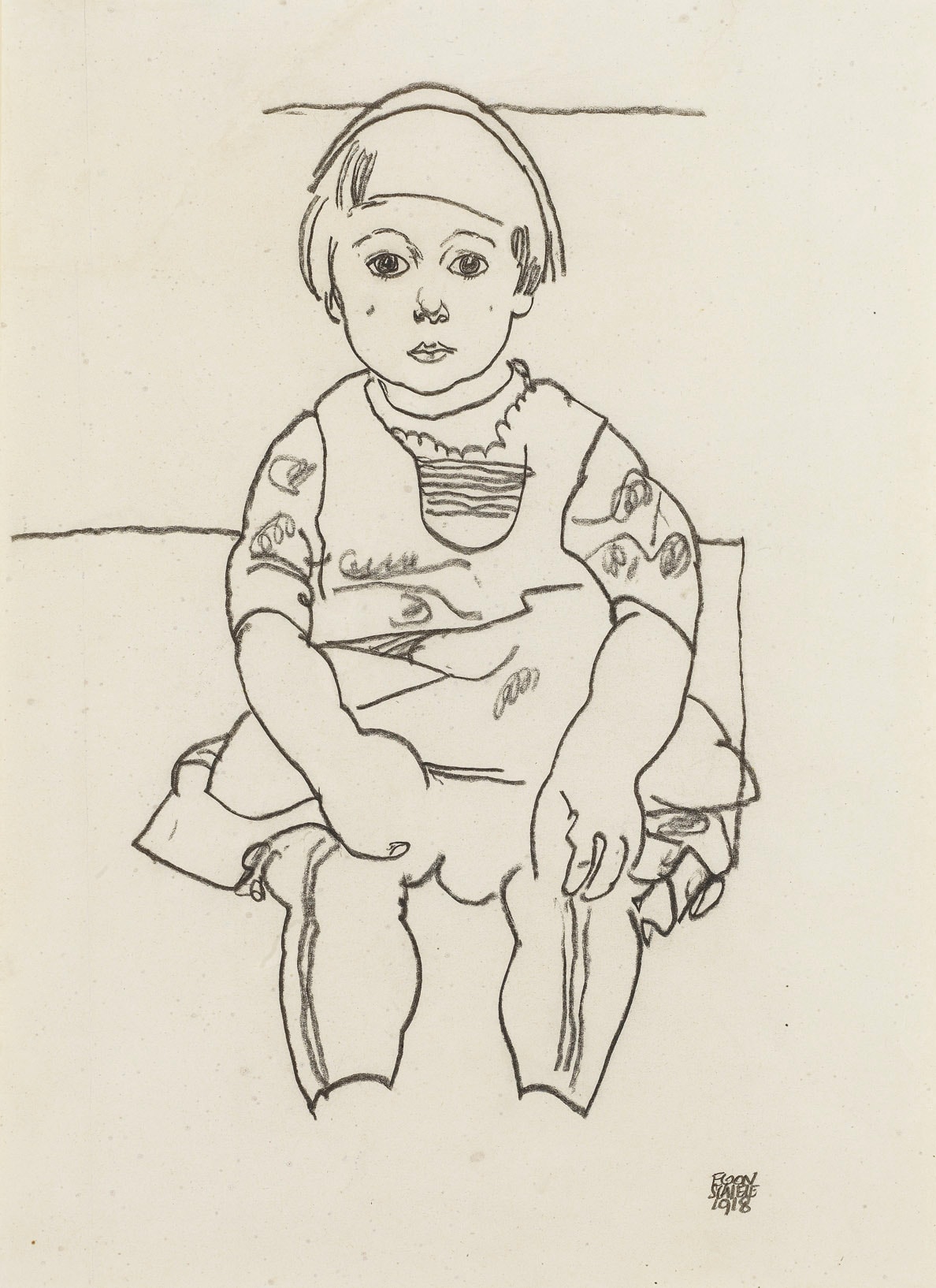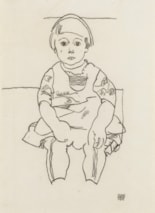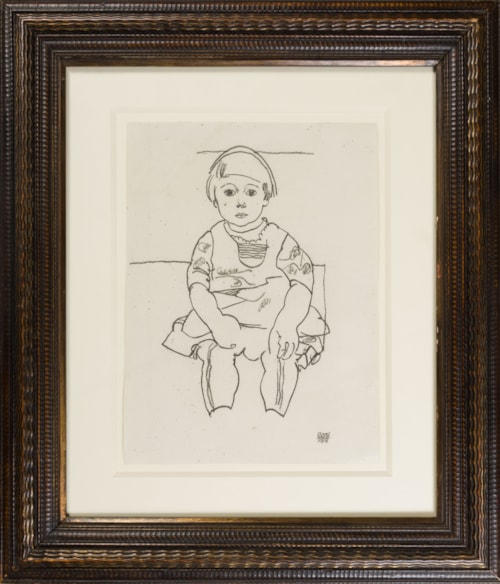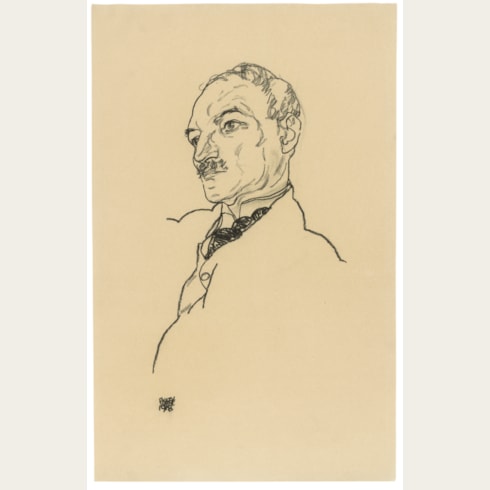Egon SCHIELE
(Tulln 1890 - Vienna 1918)
Portrait of a Child (Anton Peschka, Jr.)
Black crayon.
The upper left corner of the sheet previously torn and reattached.
Signed and dated EGON / SCHIELE / 1918 at the lower right.
381 x 283 mm. (15 x 11 1/8 in.)
The upper left corner of the sheet previously torn and reattached.
Signed and dated EGON / SCHIELE / 1918 at the lower right.
381 x 283 mm. (15 x 11 1/8 in.)
Drawn in the last months of Egon Schiele’s brief career, this is a portrait of the artist’s young nephew, Anton Peschka, Jr. The son of his younger sister Gertrude (Gerti) Schiele and Anton Peschka, a painter and close friend of the artist, the young Anton, known as ‘Toni’, was born on December 27th, 1914. Within a few months Schiele had begun to make drawings of the baby, and used him as a model for a painting of A Mother with Two Children, painted between 1915 and 1917 and today in the collection of the Österreichische Galerie in Vienna. Schiele continued to make drawings of his nephew in 1916, continuing the series of gouache and watercolour studies begun the previous year. As the boy grew older, Schiele began to develop ideas for a painted portrait of him, and to this end produced several charming drawings of the child in 1917.
The present sheet is one of only three known portrait drawings of Schiele’s young nephew to date from 1918. Of the other two drawings, likewise drawn in black crayon alone, one shows him seated on his mother’s lap, while in the other he is shown in much the same way as in this drawing, seated and facing forward. This is indeed how he appears in Schiele’s painting of 1918, which was left unfinished at the artist’s death in October of that year. In the painting, as in the present sheet and other drawings of the young Toni Peschka at the age of two or three, the child is depicted wearing a dress, which was not uncommon for small boys at that time.
In this intimate portrayal of his young nephew (who, like his father and uncle, was to become a painter and a student at the Akademie in Vienna), Schiele was able to capture something of the essence of childhood. n later years, Anton Peschka, Jr. would recall sitting for his uncle at Schiele’s studio on Hietzinger Hauptstrasse in Vienna, for which sessions his mother and the artist would always make precise appointments. He also remembered that whenever he became restless the artist would placate him with candy, and would sometimes also show him a toy steam train.
Of the drawings produced in the last year of the artist’s life, the scholar Jane Kallir was written; ‘Always the speedy worker, Schiele had finally found the perfect line. In 1917 and 1918 he was usually able to capture his subjects with a single, virtually unbroken sweep of his crayon. In his works on paper, he became more and more focused on the qualities of drawing as such, and therefore relatively few of his 1918 studies are colored. Instead he was increasingly interested in sculpting volume…Schiele had no need, as formerly, to redrawn or embellish faulty contours…he was in complete control, and in these drawings Schiele achieved an unprecedented degree of accuracy.’
The authenticity of this drawing, which is previously unpublished, has been confirmed by Jane Kallir.
The present sheet is one of only three known portrait drawings of Schiele’s young nephew to date from 1918. Of the other two drawings, likewise drawn in black crayon alone, one shows him seated on his mother’s lap, while in the other he is shown in much the same way as in this drawing, seated and facing forward. This is indeed how he appears in Schiele’s painting of 1918, which was left unfinished at the artist’s death in October of that year. In the painting, as in the present sheet and other drawings of the young Toni Peschka at the age of two or three, the child is depicted wearing a dress, which was not uncommon for small boys at that time.
In this intimate portrayal of his young nephew (who, like his father and uncle, was to become a painter and a student at the Akademie in Vienna), Schiele was able to capture something of the essence of childhood. n later years, Anton Peschka, Jr. would recall sitting for his uncle at Schiele’s studio on Hietzinger Hauptstrasse in Vienna, for which sessions his mother and the artist would always make precise appointments. He also remembered that whenever he became restless the artist would placate him with candy, and would sometimes also show him a toy steam train.
Of the drawings produced in the last year of the artist’s life, the scholar Jane Kallir was written; ‘Always the speedy worker, Schiele had finally found the perfect line. In 1917 and 1918 he was usually able to capture his subjects with a single, virtually unbroken sweep of his crayon. In his works on paper, he became more and more focused on the qualities of drawing as such, and therefore relatively few of his 1918 studies are colored. Instead he was increasingly interested in sculpting volume…Schiele had no need, as formerly, to redrawn or embellish faulty contours…he was in complete control, and in these drawings Schiele achieved an unprecedented degree of accuracy.’
The authenticity of this drawing, which is previously unpublished, has been confirmed by Jane Kallir.
In a brief artistic career that lasted just twelve years, Egon Schiele produced a few hundred paintings and nearly three thousand drawings and watercolours. Born in the town of Tulln, on the Danube river northwest of Vienna, Schiele drew obsessively from an early age. In 1906, he was accepted at the Akademie der Bildenden Künste in Vienna, where at sixteen years old he was the youngest student. The following year he met the prominent artist Gustav Klimt, who was to become a friend and mentor, and whose stylistic influence is noticeable in Schiele’s works of 1908 and 1909. In 1908 he exhibited his work in public for the first time, and the following year, at the invitation of Klimt, sent four paintings to the Internationale Kunstschau. The same year Schiele was one of several young artists who left the Academy and established the Neukunstgruppe (New Art Group), exhibiting their work at the Kunstsalon Pisko in Vienna. Through this exhibition Schiele met several important collectors and art critics, who began to acquire and promote his work. He also began to establish a reputation as a portraitist, and received a number of portrait commissions, although he nevertheless continued to struggle financially. After his first solo exhibition in Vienna in 1911, Schiele settled outside the city, eventually living in the village of Neulengbach. In 1912 he was arrested there on charges of kidnapping and rape of a minor – one of several village children who had posed for the artist - and was imprisoned for over three weeks. The artist was eventually acquitted of the charges of kidnapping and rape, but was found guilty of public immorality on account of the indecent imagery of some of his drawings.
After his release from prison Schiele returned to Vienna, and his work took on a less overtly erotic tone, with allegories, landscapes and urban scenes becoming more prominent, alongside portraits. He began to exhibit his work widely throughout Germany, and also began experimenting with printmaking. Drafted into the Austrian army in May 1915, Schiele’s poor health meant that he was assigned office duty, serving in a suburb of Vienna where he was tasked with guarding Russian prisoners of war. His work continued to be exhibited, however, although his output lessened. In 1917 he was transferred to a supply depot in Vienna, where he was able to live at home and continue to paint. It was not until the last year or so of his life that he began to achieve a modest amount of financial success. With the critical and financial success of his one-man exhibition at the Vienna Secession the following month, when every one of his works was sold, Schiele’s reputation was secured. By the final months of the First World War, and following the death of Gustav Klimt in February 1918, Schiele had become established as the leading avant-garde artist in Vienna. Sadly, this late taste of success was short-lived, as the artist died in October 1918 at the age of just twenty-eight, a victim of the worldwide Spanish flu pandemic.
After his release from prison Schiele returned to Vienna, and his work took on a less overtly erotic tone, with allegories, landscapes and urban scenes becoming more prominent, alongside portraits. He began to exhibit his work widely throughout Germany, and also began experimenting with printmaking. Drafted into the Austrian army in May 1915, Schiele’s poor health meant that he was assigned office duty, serving in a suburb of Vienna where he was tasked with guarding Russian prisoners of war. His work continued to be exhibited, however, although his output lessened. In 1917 he was transferred to a supply depot in Vienna, where he was able to live at home and continue to paint. It was not until the last year or so of his life that he began to achieve a modest amount of financial success. With the critical and financial success of his one-man exhibition at the Vienna Secession the following month, when every one of his works was sold, Schiele’s reputation was secured. By the final months of the First World War, and following the death of Gustav Klimt in February 1918, Schiele had become established as the leading avant-garde artist in Vienna. Sadly, this late taste of success was short-lived, as the artist died in October 1918 at the age of just twenty-eight, a victim of the worldwide Spanish flu pandemic.
Provenance
Private collection, Australia, since the late 1990s.
Literature
Emma Crichton-Miller, ‘Collector’s Focus: Vienna Secession works on paper’, Apollo, January 2016, p.75; Seph Rodney, ‘Subtle and Finessed Depictions at the Master Drawings Fair’, Hyperallergic, 24 January 2022.






